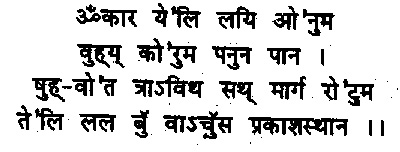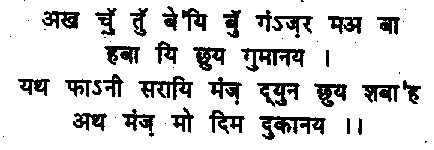Literature
& Language

Kashmir,
a seat of learning from ancient times, has produced
thinkers, philosophers, scholars and poets in all
ages. Some of the celebrated names who contributed
in different languages are:
1. Sanskrit. It
was the ancient language of religion, philosophy etc. It
continued to be the language of the courts and the
administration even during the first 100 years
(approx:) of Muslim rule (till the times of
Zain-Ul-Abidin).
i) Abhinavagupta
(933-1015 AD) ~ A poet, critic, saint, philosopher.
Wrote more than 40 books, notably some on Shaivism.
ii) Kalhana ~ Historian,
poet, author of Rajatarangini in 8000 verses of high
poetic merit.
iii) Kshemendra ~ His
contribution to Sanskrit literature is unique. He
authored Samayamatrika.
iv) Jonaraja, Srivara,
Sukha ~ carried the work of Kalhana in Sanskrit.
v) Hieun Tsang and Ou-Kong
travelled from China to learn Sanskrit in order to
read Buddhist thought already written in Sanskrit.
2. Persian
With the advent of
Muslim rule and introduction of Persian as court
language, Kashmiri Pandits adopted Persian as the
language for literary work. Pandit Narayan Koul,
Pandit Chandra Bhan, Pandit Bhawanidas Kachroo, Gani
Kashmiri, Pandit Raj Koul Arzbegi, Dewan Kripa Ram
(in the reign of Gulab Singh) are prominent names.
3. Kashmiri
The Language:
Kashmiri is the language spoken by the people living in
Kashmir Valley and with some variance on its
border like Kishtwar, Banihal etc. Although no
specific account is available of its origin, its
evolution from Sanskrit (rather its older version
- the Vedic Sanskrit) is evident from its texture and
vocabulary. The theory of Sir George Grierson that it is
a part of Central Asian Dardic group of languages,
has since been discredited. It appears that the
mother tongue of the Indo Aryan, who settled in Kashmir,
must have been Sanskrit (or the Vedic Sanskrit).
In course of time, it changed into Prakrat and then to
Kashmiri.
The earliest written
material available is Mahanaya Prakash of Siti Kantha.
It is about a hundred years after Kalhana and is
in old Kashmiri. But from Kalhana’s writing, it
appears that the language had already made inroads
before his time (12th century AD). The earliest
writings in modern Kashmiri are only from
Lalla-Ded (14th century AD). The language has absorbed
words from Persian, Arabic and dialects spoken on
the Valley’s fringes.
The language has a large
number of vowel sounds. A slight stress on a
particular sound can change a word into another one of
entirely different meaning. Kashmiri verb assumes
many shapes according to number, gender, person and
tense. All this has given it a rich vocabulary. It
has a rich collection of Proverbs, an own stock of
Riddles (Pratsa), and, a very well developed poetics.
The Script: The
earliest available Kashmiri manuscripts are written in
the Sharada script. This script was widely
used by scholars, rulers, common people of all
religious denominations alike. Among Hindus, it was used
for transcribing Sanskrit texts as well as
compositions in Kashmiri. The Sharada script was much
in use not only in Kashmir, but also in North Western
India (Gilgit etc.), Punjab and Himachal Pradesh
and even in Central Asia. This script enjoys a foremost
position among all the ancient Indian scripts. It was
evolved from the Western branch of Brahmi nearly
1200 years ago. Almost all the ancient Sanskrit
literature is written in this script. The earliest
Sharada inscription discovered on a stone slab at
the village Hund at Attock, Pakistan, date back to 774
AD. According to Pt. Anand Koul Bamzai, Sharada
alphabets were used in stone inscriptions even up
to 18th century. This is corroborated by his discovery
of a Sharada inscription dated Vikram 1846 (1789
AD). This script is said to have reached
perfection by the 15th or 16th century. The epigraphists
Kielhorn and Hoernle hold the view that Sharada
alphabet is a very conservative alphabet as it changed
very little across the centuries.
Sharada script was
replaced by Persian /Urdu scripts when Kashmir came
under Mughal and Afghan rule. The Kashmiri Pandits,
nevertheless mastered Persian language and script
and used it widely in official and private
communications. This relegated Sharada to the
background, being limited to religious & devotional
texts & writing and calculating astrological and
ritual f.mp3ulations.
The history of the
adoption and modification of the Devanagari script for
Kashmiri has not been documented authentically. But the
very fact that the script was used freely by
eminent western linguists like Grierson and Temple in
their profound works and treatises on Kashmiri
language and literature is ample proof of its
having been standardised over the decades in the 19th
century. This universally acceptable writing
system came handy to the intelligent and discerning
community of Kashmiri Pandits for whom the Indian
connection has always been primary. Benefitting
from the experience of this enlightened community, the
Western research scholars like Grierson, Buhlar, Temple,
Stein etc. associated renowned scholars of their
times like Mukund Ram Shastri and Ishwar Koul with their
work and modified the Devanagari of Kashmir as against
the Persian script. The qualities of better
phonetic representation inherent in Devanagari seems to
have weighed more with these discerning scholars.
Writers
and Scholars:
There has been
considerable contribution to Kashmiri language from the
Poets. A number of them belong to the Mystic
genre. Mystic poetry , according to Late
Moti Lal Saqi is “reflection of spiritual way of life.
It has esoteric content which sows the seeds of
metaphysics and rhythm of life. It is receptacle which
overflows with peace and intrinsic love for the entire
humanity without boundaries of caste &
creed”. Kashmir, which is often called ‘Resh Waer’
has been the cradle genre of many a mystic poets.
Some of the more known and popular mystic poets of
Kashmir are Lalla-Ded, Nunda Resh, Swachha Kral, Neyma
Saab, Shamas Faqir, Wahab Khar, P.mp3anand, Rupa
Bhawani, Maqbool Shah Kralwari, Ahad Zargar, Samad
Meer and hosts of other lesser known mystic poets,
who have treaded the Vale of Kashmir between 14th
& 19th centuries.
Prominent
Poets:
Lalla-Ded (Lalleshwari)
was perhaps the first Kashmiri poetess. She is regarded
as the founder of modern Kashmiri language as well as
literature. Her Vaakhs preach tolerance and
h.mp3ony. She was born in the 14th century (year
disputed). All legends, fables or folklore of
those times agree that Lalla-Ded came from a
well-to-do family and was married into a household,
where her mother-in-law and even her husband, it
is said, were not kindly disposed towards her.
Disappointment in love and domestic life turned the born
mystic into an ascetic, wandering from village to
village. She came under the influence of guru Siddha Sri
Kantha or Siddha Mol - a great scholar, who
eventually became her spiritual perceptor. It was
this man who initiated her into Shaivite cult. Her
internal spiritual lotus bloomed and she became a
devout follower of ‘Trik’ philosophy and turned
increasingly towards mysticism. There is hardly any
Kashmiri house where her ‘Vaakhs’ do not
reverberate and fill the air with the celestial aroma,
even today.
Lalla was mystic to the
core and a born saint, who laid stress on the inner
quest and sincere pursuit of spiritual perfection. To
uplift people out of the Bog, she draws the
attention of the aspirants to the foot prints she left
behind.

Swachha Kral:
Nothing is more reliably known about Swachha Kral who is
believed to have been born in 1774 AD. His date of
death inscribed on the Tomb-stone (which is of
recent origin) is as 29th of November 1854. It is said
that he was born in a family of potters in a
remote village of Yender near Pulwama. His poetry,
most of which has remained untraced, indicated that he
was academically illiterate but spiritually,
highly evolved. He was an ardent believer of One-God
concept (monoism). He believed that life on the earth
was a transitory abode for man and his eternal
abode was in the God’s land. So, Swachha Kral, in his
numerous poems has exhorted that one should not give in
to the temptation of this world, but should crave
for the eternal bliss through one’s righteous deeds in
this world. Here are some introductory lines from his
few poem which peep into his profound mystic mind:

 Click
here for the song sung by Vijay Malla Click
here for the song sung by Vijay Malla
P.mp3anand (real
name Nand Ram) was born in 1790 in a village near
Mattan. Well versed in Persian on the one hand and
the Vaishnava lore on the other, and knowing some
Sanskrit, P.mp3anand took recourse to poetry for coveying
his philisophy. Fed up with his work at the
revenue department, he resigned his post as Patwari
after 15 years of service. The profound sayings of
Lalla-Ded and the study of Bhagvata Gita and the
Upanishads buoyed him up untill the realisation
came to him that true spirituality lay in rising above
the illusion - maya and not merely being
other-worldly. He effected the synthesis of Sufism with
the Vedanta. He penned Radha Svayamvara, Sudama Charitra,
Shivalagan etc. He died in 1878.
Zinda Kaul -
Masterji was one of the most notable poets of his times.
He is the first Kashmiri poet who won the Indian
Sahitya Akademi Award in 1956. He showed great
proficiency in learning Persian from a very early age
and wrote poetry in that language under the pen
name of Sabit. Masterji started writing in
Kashmiri in early forties when he was fifty eight years
of age. He wrote mysticism in simple metaphor. His
collection of thirty five Kashmiri poems Sumran won him
the most prestigious award. Kashmiri Shaivism, Vedanta
and Upanishads are portrayed most eloquently in
Sumran. Masterji remains one of the foremost poets of
the twentieth century. He left his mortal
frame on 4th April 1966.
Arnimal. Born in
the 18th century, Arnimal fashioned the Lol lyric into
plaintive wails, poignant and melancholic. Like
Lalla-Ded and Habba Khatun, Arnimal’s family
life was unhappy, which contributed to the poignant
pathos and the recurring note of resignation to
fate in her poems. She was married to Bhawanidas
Kachroo, a Persian poet (and a minister) who deserted
her and she lived mostly in her father’s home.
The romantic poems of Arnimal constitute a watershed in
the development of Kashmiri poetry.
Habba Khatun.
Born in village Chandahar, Zooni (Habba Khatun’s
maiden name) was a precocious child and learnt the
Quran and Persian classics. Her songs, remarkable
for melody and spontaneity, expressed the deep craving
of the heart and the soul. She and her successor,
Arnimal, were the precursors of the romantic
movement in Kashmiri poetry. Scared of her fame, her
father had her married off to an illiterate
peasant, who did not appreciate her songs. While
singing, she caught the eye of prince Yusuf Shah
Chak, who fell in love with her. He arranged for
her divorce and married her. She and her royal consort
founded Gulmarg. She has been called the Nur Jahan
of Kashmir.
Ghulam Ahmad Mahjoor.
Born on 3 September, 1885 in Mitragam village, about 37
Kms. from Srinagar, Ghulam Ahmad Mahjoor received poetic
inspiration from his father who was a Persian
scholar. Det.mp3ined to write in his own mother tongue,
Mahjoor used the simple diction of the folk. With his
emergence, Kashmiri literature entered a period of
creative poetic revival. His poem Baghe Nishat Ke
Gulo became popular throughout the Valley. When
recognised by Rabindranath Tagore, the Kashmiri
bard’s fame spread beyond the Vale of Kashmir. His
poetry increasingly epitomised the struggle of
Kashmiris for self government. Among the poets of
the ‘New Kashmir’ period, Mahjoor ranked as the
greatest in the love of his motherland. Mahjoor
showed his keen awareness of the changing times in poems
like Wolo ho baagvano and Gulshan vatan chhu sonuy.
Kashmir lost this greatest poet of the century on
9 April 1952.
|
